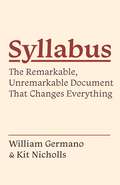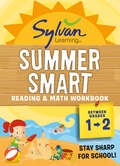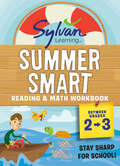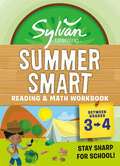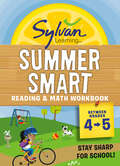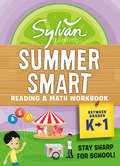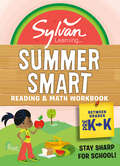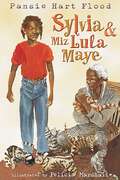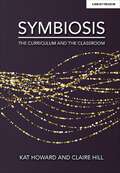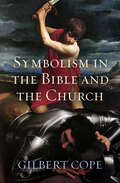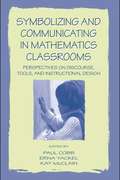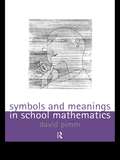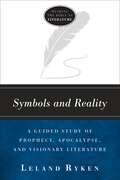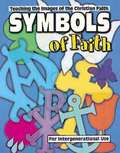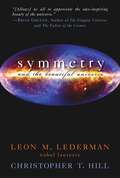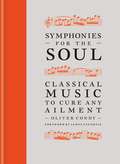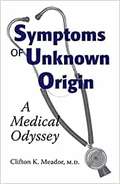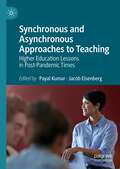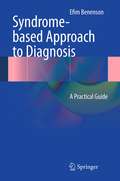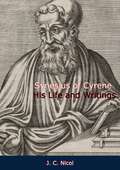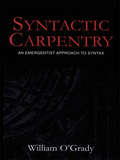- Table View
- List View
Syllabus: The Remarkable, Unremarkable Document That Changes Everything (Skills for Scholars)
by William Germano Kit NichollsHow redesigning your syllabus can transform your teaching, your classroom, and the way your students learnGenerations of teachers have built their classes around the course syllabus, a semester-long contract that spells out what each class meeting will focus on (readings, problem sets, case studies, experiments), and what the student has to turn in by a given date. But what does that way of thinking about the syllabus leave out—about our teaching and, more importantly, about our students’ learning?In Syllabus, William Germano and Kit Nicholls take a fresh look at this essential but almost invisible bureaucratic document and use it as a starting point for rethinking what students—and teachers—do. What if a teacher built a semester’s worth of teaching and learning backward—starting from what students need to learn to do by the end of the term, and only then selecting and arranging the material students need to study?Thinking through the lived moments of classroom engagement—what the authors call “coursetime”—becomes a way of striking a balance between improv and order. With fresh insights and concrete suggestions, Syllabus shifts the focus away from the teacher to the work and growth of students, moving the classroom closer to the genuinely collaborative learning community we all want to create.
Sylvan Summer Smart Workbook: Between Grades 1 & 2 (Sylvan Summer Smart Workbooks)
by Sylvan LearningStop "summer slide" and get ready to return to the classroom for 2nd grade with Sylvan's SUMMER SMART Workbooks!Research shows that kids can lose up to 2.5 months' worth of hard-earned knowledge from the previous grade over the summer vacation break. That's why we at Sylvan Learning—America's #1 tutoring brand—created the SUMMER SMART workbook series!Packed with fun exercises and teacher-created activities, this book reinforces math and reading concepts your child learned in 1st grade, including: • Numbers and counting• Addition and subtraction• Basic measurements• Short and long vowels• Words to know• Reading comprehensionInside each Summer Smart book, you'll also find:• Teacher tips for staying sharp over the summer• Special &“Vacation Challenge!&” activities and games section• Cut-out flashcard sheets and recommended reading lists• A &“Summer Smart!&” Achievement CertificateLet the experts at America's #1 tutoring brand help get your child ready for 2nd grade!***** Why Sylvan Products Work ***** Sylvan Learning Workbooks won a National Parenting Publications Awards (NAPPA) Honors Award as a top book series for children in the elementary-aged category. NAPPA is the nation&’s most comprehensive awards program for children&’s products and parenting resources and has been critically reviewing products since 1990. The Award recognizes Sylvan Learning Workbooks as some of the most innovative and useful products geared to parents. Sylvan's proven system inspires kids to learn and has helped children nationwide catch up, keep up, and get ahead in school. Sylvan has been a trusted partner for parents for thirty years, and has based their supplemental education success on programs developed through a focus on the highest educational standards and detailed research. Sylvan&’s line of educational products equips families with fun, effective, and grade-appropriate learning tools. Our workbooks and learning kits feature activities, stories, and games to reinforce the skills children need to develop and achieve their academic potential. Students will reap the rewards of improved confidence and a newfound love of learning.
Sylvan Summer Smart Workbook: Between Grades 2 & 3 (Sylvan Summer Smart Workbooks)
by Sylvan LearningStop "summer slide" and get ready to return to the classroom for 3rd grade with Sylvan's SUMMER SMART Workbooks!Research shows that kids can lose up to 2.5 months' worth of hard-earned knowledge from the previous grade over the summer vacation break. That's why we at Sylvan Learning—America's #1 tutoring brand—created the SUMMER SMART workbook series!Packed with fun exercises and teacher-created activities, this book reinforces math and reading concepts your child learned in 2nd grade, including: • Addition and subtraction• Basic fractions• Time and money• Measuring and comparing• Vowels and consonants• Compound words and contractions• Reading comprehensionInside each Summer Smart book, you'll also find:• Teacher tips for staying sharp over the summer• Special &“Vacation Challenge!&” activities and games section• Cut-out flashcard sheets and recommended reading lists• A &“Summer Smart!&” Achievement CertificateLet the experts at America's #1 tutoring brand help get your child ready for 3rd grade!***** Why Sylvan Products Work ***** Sylvan Learning Workbooks won a National Parenting Publications Awards (NAPPA) Honors Award as a top book series for children in the elementary-aged category. NAPPA is the nation&’s most comprehensive awards program for children&’s products and parenting resources and has been critically reviewing products since 1990. The Award recognizes Sylvan Learning Workbooks as some of the most innovative and useful products geared to parents. Sylvan's proven system inspires kids to learn and has helped children nationwide catch up, keep up, and get ahead in school. Sylvan has been a trusted partner for parents for thirty years, and has based their supplemental education success on programs developed through a focus on the highest educational standards and detailed research. Sylvan&’s line of educational products equips families with fun, effective, and grade-appropriate learning tools. Our workbooks and learning kits feature activities, stories, and games to reinforce the skills children need to develop and achieve their academic potential. Students will reap the rewards of improved confidence and a newfound love of learning.
Sylvan Summer Smart Workbook: Between Grades 3 & 4 (Sylvan Summer Smart Workbooks)
by Sylvan LearningStop "summer slide" and get ready to return to the classroom for 4th grade with Sylvan's SUMMER SMART Workbooks!Research shows that kids can lose up to 2.5 months' worth of hard-earned knowledge from the previous grade over the summer vacation break. That's why we at Sylvan Learning—America's #1 tutoring brand—created the SUMMER SMART workbook series!Packed with fun exercises and teacher-created activities, this book reinforces math and reading concepts your child learned in 3rd grade, including: • Addition and subtraction • Multiplication and division• Fractions, weights and measurements• Context clues and predicting what happens• Main ideas and details• Story comprehensionInside each Summer Smart book, you'll also find:• Teacher tips for staying sharp over the summer• Special &“Vacation Challenge!&” activities and games section• Cut-out flashcard sheets and recommended reading lists• A &“Summer Smart!&” Achievement CertificateLet the experts at America's #1 tutoring brand help get your child ready for 4th grade!***** Why Sylvan Products Work ***** Sylvan Learning Workbooks won a National Parenting Publications Awards (NAPPA) Honors Award as a top book series for children in the elementary-aged category. NAPPA is the nation&’s most comprehensive awards program for children&’s products and parenting resources and has been critically reviewing products since 1990. The Award recognizes Sylvan Learning Workbooks as some of the most innovative and useful products geared to parents. Sylvan's proven system inspires kids to learn and has helped children nationwide catch up, keep up, and get ahead in school. Sylvan has been a trusted partner for parents for thirty years, and has based their supplemental education success on programs developed through a focus on the highest educational standards and detailed research. Sylvan&’s line of educational products equips families with fun, effective, and grade-appropriate learning tools. Our workbooks and learning kits feature activities, stories, and games to reinforce the skills children need to develop and achieve their academic potential. Students will reap the rewards of improved confidence and a newfound love of learning.
Sylvan Summer Smart Workbook: Between Grades 4 & 5 (Sylvan Summer Smart Workbooks)
by Sylvan LearningStop "summer slide" and get ready to return to the classroom for 5th grade with Sylvan's SUMMER SMART Workbooks!Research shows that kids can lose up to 2.5 months' worth of hard-earned knowledge from the previous grade over the summer vacation break. That's why we at Sylvan Learning—America's #1 tutoring brand—created the SUMMER SMART workbook series!Packed with fun exercises and teacher-created activities, this book reinforces math and reading concepts your child learned in 4th grade, including: • Addition and subtraction • Multiplication and division• Fractions and decimals• Time and money• Facts and opinions• Comparing and contrasting• Story-planning• Reading between the linesInside each Summer Smart book, you'll also find:• Teacher tips for staying sharp over the summer• Special &“Vacation Challenge!&” activities and games section• Cut-out flashcard sheets and recommended reading lists• A &“Summer Smart!&” Achievement CertificateLet the experts at America's #1 tutoring brand help get your child ready for 5th grade!***** Why Sylvan Products Work ***** Sylvan Learning Workbooks won a National Parenting Publications Awards (NAPPA) Honors Award as a top book series for children in the elementary-aged category. NAPPA is the nation&’s most comprehensive awards program for children&’s products and parenting resources and has been critically reviewing products since 1990. The Award recognizes Sylvan Learning Workbooks as some of the most innovative and useful products geared to parents. Sylvan's proven system inspires kids to learn and has helped children nationwide catch up, keep up, and get ahead in school. Sylvan has been a trusted partner for parents for thirty years, and has based their supplemental education success on programs developed through a focus on the highest educational standards and detailed research. Sylvan&’s line of educational products equips families with fun, effective, and grade-appropriate learning tools. Our workbooks and learning kits feature activities, stories, and games to reinforce the skills children need to develop and achieve their academic potential. Students will reap the rewards of improved confidence and a newfound love of learning.
Sylvan Summer Smart Workbook: Between Grades K & 1 (Sylvan Summer Smart Workbooks)
by Sylvan LearningStop "summer slide" and get ready to return to the classroom for 1st grade with Sylvan's SUMMER SMART Workbooks!Research shows that kids can lose up to 2.5 months' worth of hard-earned knowledge from the previous grade over the summer vacation break. That's why we at Sylvan Learning—America's #1 tutoring brand—created the SUMMER SMART workbook series!Packed with fun exercises and teacher-created activities, this book reinforces math and reading concepts your child learned in kindergarten, including: • Numbers• Patterns • Shapes • Letters and sounds • Words to know• Story comprehensionInside each Summer Smart book, you'll also find:• Teacher tips for staying sharp over the summer• Special &“Vacation Challenge!&” activities and games section• Cut-out flashcard sheets and recommended reading lists• A &“Summer Smart!&” Achievement CertificateLet the experts at America's #1 tutoring brand help get your child ready for 1st grade!***** Why Sylvan Products Work ***** Sylvan Learning Workbooks won a National Parenting Publications Awards (NAPPA) Honors Award as a top book series for children in the elementary-aged category. NAPPA is the nation&’s most comprehensive awards program for children&’s products and parenting resources and has been critically reviewing products since 1990. The Award recognizes Sylvan Learning Workbooks as some of the most innovative and useful products geared to parents. Sylvan's proven system inspires kids to learn and has helped children nationwide catch up, keep up, and get ahead in school. Sylvan has been a trusted partner for parents for thirty years, and has based their supplemental education success on programs developed through a focus on the highest educational standards and detailed research. Sylvan&’s line of educational products equips families with fun, effective, and grade-appropriate learning tools. Our workbooks and learning kits feature activities, stories, and games to reinforce the skills children need to develop and achieve their academic potential. Students will reap the rewards of improved confidence and a newfound love of learning.
Sylvan Summer Smart Workbook: Between Grades Pre-K & Kindergarten (Sylvan Summer Smart Workbooks)
by Sylvan LearningStop "summer slide" and get ready to return to the classroom for kindergarten with Sylvan's SUMMER SMART Workbooks!Research shows that kids can lose up to 2.5 months' worth of hard-earned knowledge from the previous grade over the summer vacation break. That's why we at Sylvan Learning—America's #1 tutoring brand—created the SUMMER SMART workbook series!Packed with fun exercises and teacher-created activities, this book reinforces math and reading concepts your child learned in pre-k, including: • Basic numbers and counting • Upper and lowercase letters• Drawing numbers • Drawing lettersInside each Summer Smart book, you'll also find:• Teacher tips for staying sharp over the summer• Special &“Vacation Challenge!&” activities and games section• Cut-out flashcard sheets and recommended reading lists• A &“Summer Smart!&” Achievement CertificateLet the experts at America's #1 tutoring brand help get your child ready for kindergarten!***** Why Sylvan Products Work ***** Sylvan Learning Workbooks won a National Parenting Publications Awards (NAPPA) Honors Award as a top book series for children in the elementary-aged category. NAPPA is the nation&’s most comprehensive awards program for children&’s products and parenting resources and has been critically reviewing products since 1990. The Award recognizes Sylvan Learning Workbooks as some of the most innovative and useful products geared to parents. Sylvan's proven system inspires kids to learn and has helped children nationwide catch up, keep up, and get ahead in school. Sylvan has been a trusted partner for parents for thirty years, and has based their supplemental education success on programs developed through a focus on the highest educational standards and detailed research. Sylvan&’s line of educational products equips families with fun, effective, and grade-appropriate learning tools. Our workbooks and learning kits feature activities, stories, and games to reinforce the skills children need to develop and achieve their academic potential. Students will reap the rewards of improved confidence and a newfound love of learning.
Sylvia & Miz Lula Maye (Exceptional Reading And Language Arts Titles For Intermediate Grades Ser.)
by Pansie Hart FloodWhen 10-year-old Sylvia Freeman moves to Wakeview, South Carolina, she's sure that her summer is going to be plain ol' boring—that is until she meets her 99-year-old neighbor, Miz Lula Maye. It's always been just Sylvia and her momma, but as the hot summer days pass, she finds herself heading down the dusty dirt road that runs from her house to Miz Lula Maye's more and more. With Miz Lula Maye, everything is an adventure, whether they're swaying on the porch swing or chasing after missing cats. Then, one day, a stranger comes to town with news about Sylvia's past that changes her life forever. With her world turned upside-down, what can Sylvia do?
Symbiosis: The Curriculum and the Classroom
by Kat Howard Claire HillHas our system of accountability and quick fixes meant we've lost perspective of what can really improve the quality of education? With a multitude of issues at the heart of some of our more toxic schools, including micro-management, over-complicated policy and the intricate measurement of the wrong foci, it appears that teachers are experiencing a disconnect from the very reason they joined teaching in the first place. With little autonomy over what's important, fewer teachers enter the profession than the monumental amount of teachers that are leaving, and those that do, do so with reluctance and regret. With an astute examination of practice in schools, Claire Hill and Kat Howard take a thoughtful and strategic view of how to ensure a sense of connection and cohesion within schools, to ensure that all feel part of the collective curricular journey towards a gold standard. With a consideration of research-informed practice, this book will provide a series of strategies for curriculum designers at every level, keeping the high quality teachers that we very much need in schools, and providing a better palette to students in the process. At a time where teaching is somewhat politicised, monetised and overcomplicated, Symbiosis: Curriculum and the Classroom sets about the task of refining the way in which we run our schools to improve the quality of our everyday lives in schools.
Symbiosis: The Curriculum and the Classroom
by Kat Howard Claire HillHas our system of accountability and quick fixes meant we've lost perspective of what can really improve the quality of education? With a multitude of issues at the heart of some of our more toxic schools, including micro-management, over-complicated policy and the intricate measurement of the wrong foci, it appears that teachers are experiencing a disconnect from the very reason they joined teaching in the first place. With little autonomy over what's important, fewer teachers enter the profession than the monumental amount of teachers that are leaving, and those that do, do so with reluctance and regret. With an astute examination of practice in schools, Claire Hill and Kat Howard take a thoughtful and strategic view of how to ensure a sense of connection and cohesion within schools, to ensure that all feel part of the collective curricular journey towards a gold standard. With a consideration of research-informed practice, this book will provide a series of strategies for curriculum designers at every level, keeping the high quality teachers that we very much need in schools, and providing a better palette to students in the process. At a time where teaching is somewhat politicised, monetised and overcomplicated, Symbiosis: Curriculum and the Classroom sets about the task of refining the way in which we run our schools to improve the quality of our everyday lives in schools.
Symbolism in the Bible and Church
by Gilbert CopeA theologian explores the rich imagery and symbolism of the Bible and the Church, offering a new path for spiritual inspiration in the modern era. Does the imagery of the Bible correspond to our present understanding of the human psyche and its environment? Do the doctrinal and ritual patterns of the Church offer effective structure and spiritual orientation for modern life? In Symbolism in the Bible and the Church, theologian Gilbert Cope evaluates these pillars of traditional Hebrew-Christian &“mythology&” in light of our post-Darwinian, post-Freudian, and post-Einsteinian age. In this lucid and wide-ranging study, Cope argues that the imagery and symbolism of the Bible and the Church are more vital than ever. While the scientific method has opened a door to knowledge, it has also opened a door to ignorance. The more we discover, the more we realize how little we know.
Symbolizing and Communicating in Mathematics Classrooms: Perspectives on Discourse, Tools, and Instructional Design
by Paul Cobb Erna Yackel Kay McClainThis volume grew out of a symposium on discourse, tools, and instructional design at Vanderbilt University in 1995 that brought together a small international group to grapple with issues of communicating, symbolizing, modeling, and mathematizing, particularly as these issues relate to learning in the classroom. The participants invited to develop chapters for this book--all internationally recognized scholars in their respective fields--were selected to represent a wide range of theoretical perspectives including mathematics education, cognitive science, sociocultural theory, and discourse theory. The work is distinguished by the caliber of the contributors, the significance of the topics addressed in the current era of reform in mathematics education, and the diversity of perspectives taken to a common set of themes and issues. The book is intended for those who are seeking to expand their understanding of the complexity of learning in order to enhance the learning experiences students have in schools, primarily researchers, instructional designers, and graduate students in mathematics education, as well as those in other fields including science education, instructional design in general, discourse theory, and semiotics.
Symbols and Meanings in School Mathematics
by David PimmSymbols and Meanings in School Mathematics explores the various uses and aspects of symbols in school mathematics and also examines the notion of mathematical meaning. It is concerned with the power of language which enables us to do mathematics, giving us the ability to name and rename, to transform names and to use names and descriptions to conjure, communicate and control our images. It is in the interplay between language, image and object that mathematics is created and can be communicated to others. The book also addresses a set of questions of particular relevance to the last decade of the twentieth century, which arise due to the proliferation of machines offering mathematical functioning.
Symbols and Reality: A Guided Study of Prophecy, Apocalypse, and Visionary Literature (Reading the bible as literature)
by Leland RykenThis is the fifth of a six-volume series called Reading the Bible as Literature. In this volume, the author not only explores the intersection of the Bible and literature, but he also shows pastors, students, and teachers of the Bible how to appreciate the craftsmanship of visionary literature and prophetic oracles and how to interpret them correctly. Dr. Ryken goes one step further than merely explaining the genre by including exercises to help students master this rich literary treasure. Speaking of the entire series, Ryken says, "The niche that these volumes are designed to fill is the literary approach to the Bible. This has been my scholarly passion for nearly half a century. It is my belief that a literary approach to the Bible is the common reader's friend, in contract to the more specialized types of scholarship on the Bible."
Symbols of Faith: Teaching Images of the Christian Faith
by Marcia StonerFor centuries, symbols of faith have reminded people of the nature of God and Jesus. Even when people could not read, symbols such as the cross helped people understand God's great love for us through Jesus Christ. Symbols such as the fish, or icthus, identified early Christians to one another, and still identifies Christians today. Symbols of faith are part of our history as people of faith. This resource includes over 60 Christian symbols with activities designed to teach the background of each symbol. Reproducible patterns included for most symbols.
Symmetry and the Beautiful Universe
by Christopher T. Hill Leon M. LedermanWhen scientists peer through a telescope at the distant stars in outer space or use a particle-accelerator to analyze the smallest components of matter, they discover that the same laws of physics govern the whole universe at all times and all places. Physicists call the eternal, ubiquitous constancy of the laws of physics symmetry. Symmetry is the basic underlying principle that defines the laws of nature and hence controls the universe. This all-important insight is one of the great conceptual breakthroughs in modern physics and is the basis of contemporary efforts to discover a grand unified theory to explain all the laws of physics. Nobel Laureate Leon M. Lederman and physicist Christopher T. Hill explain the supremely elegant concept of symmetry and all its profound ramifications to life on Earth and the universe at large in this eloquent, accessible popular science book. They not only clearly describe concepts normally reserved only for physicists and mathematicians, but they also instill an appreciation for the profound beauty of the universe's inherent design. Central to the story of symmetry is an obscure, unpretentious, but extremely gifted German mathematician named Emmy Noether. Though still little known to the world, she impressed no less a scientist than Albert Einstein, who praised her "penetrating mathematical thinking." In some of her earliest work she proved that the law of the conservation of energy was connected to the idea of symmetry and thus laid the mathematical groundwork for what may be the most important concept of modern physics. Lederman and Hill reveal concepts about the universe, based on Noether's work, that are largely unknown to the public and have wide-reaching implications in connection with the Big Bang, Einstein's theory of relativity, quantum mechanics, and many other areas of physics. Through ingenious analogies and illustrations, they bring these astounding notions to life. This book will open your eyes to a universe you never knew existed.
Symphonies and Other Orchestral Works
by Donald Francis ToveyOver 100 critical essays about symphonies and other orchestral works from the author.
Symphonies for the Soul: Classical music to cure any ailment
by Oliver Condy***With a foreword by James NaughtieWithin the pages of this book lie musical prescriptions that offercomfort, solace and strength in the face of dark times.Whether you suffer from loneliness or laziness, from bereavement or betrayal, a heartbreak or a mere hangover, here you'll find the perfect piece of classical music to heal the heart, soothe the soul and cure the maladies of the modern world.Musician and writer Oliver Condy takes the role of musical physician, using his years of experience to prescribe remedies for all manner of ailments in the form of classical music.A beautifully-packaged gift book with more than 100 recommendations, Symphonies for the Soul is filled with fascinating stories behind the pieces and composers selected, and how in their own unique ways they can nourish the spirit in times of need.
Symphonies for the Soul: Classical music to cure any ailment
by Oliver Condy***With a foreword by James NaughtieWithin the pages of this book lie musical prescriptions that offer comfort, solace and strength in the face of dark times.Whether you suffer from loneliness or laziness, from bereavement or betrayal, a heartbreak or a mere hangover, here you'll find the perfect piece of classical music to heal the heart, soothe the soul and cure the maladies of the modern world.Musician and writer Oliver Condy takes the role of musical physician, using his years of experience to prescribe remedies for all manner of ailments in the form of classical music.A beautifully-packaged gift book with more than 100 recommendations, Symphonies for the Soul is filled with fascinating stories behind the pieces and composers selected, and how in their own unique ways they can nourish the spirit in times of need.
Symptoms of Unknown Origin: A Medical Odyssey
by Clifton K. M.D.For years after graduating from medical school, Dr. Clifton K. Meador assumed that symptoms of the body, when obviously not imaginary, indicate a disease of the body--something to be treated with drugs, surgery, or other traditional means. But, over several decades, as he saw patients with clear symptoms but no discernable disease, he concluded that his own assumptions were too narrow and, indeed, that the underlying basis for much of clinical medicine was severely limited. Recounting a series of fascinating case studies, Meador shows in this book how he came to reject a strict adherence to the prevailing biomolecular model of disease and its separation of mind and body. He studied other theories and approaches--George Engel's biopsychosocial model of disease, Michael Balint's study of physicians as pharmacological agents--and adjusted his practice accordingly to treat what he called "nondisease." He had to retool, learn new and more in-depth interviewing and listening techniques, and undergo what Balint termed a "slight but significant change in personality." In chapters like "The Woman Who Believed She Was a Man" and "The Diarrhea of Agnes," Meador reveals both the considerable harm that can result from wrong diagnoses of nonexistent diseases and the methods he developed to help patients with chronic symptoms not defined by a medical disease. Throughout the book, he recommends subsequent studies to test his observations, and he urges full application of the scientific method to the doctor-patient relationship, pointing out that few objective studies of these all-important interactions have ever been done.
Synchronous and Asynchronous Approaches to Teaching: Higher Education Lessons in Post-Pandemic Times
by Payal Kumar Jacob EisenbergThis book examines synchronous and asynchronous teaching in light of the COVID-19 pandemic. Within a few weeks, millions of teachers found themselves forced to teach online, often with little systematic preparation and in their own homes. While this mode of teaching was earlier seen to be supplementary to brick-and-mortar classes, online teaching has become pivotal to the classroom experience. The chapter authors write of shared experiences that encapsulate the challenges faced by faculty, students and also higher education institutions. The book covers what worked, what did not work and what had to be changed during the rapid shift to online synchronous and asynchronous teaching during the lockdowns. Comprising both theoretical and practical perspectives, this book provides one of the first authoritative analyses of the field, while gathering lessons to be learned from the pandemic.
Syndrome-based Approach to Diagnosis
by Efim BenensonMany young, inexperienced doctors, have difficultly pinpointing a diagnosis: Is it a condition to which certain diseases could belong, or a disease definable in line with certain criteria? How can I apply my basic knowledge of diseases to a real patient? How can I find the correct diagnosis for a disease that I am seeing for the very first time? The traditional diagnostic pathways conveyed by current methods of teaching, from visual identification of the disease, knowledge of diseases, understanding of symptoms or patterns to diagnosis, leave certain diagnostic questions unanswered, especially on first experience of such a clinical pattern. Syndrome-based Approach to Diagnosis: A Practical Guide offers lecturers an alternative training concept in their teaching, which provides students with a model for self-study as well as the educational tools for learning how to think in clinical terms.
Synesius of Cyrene His Life and Writings: His Life And Writings
by J. C. NicolSynesius was a Greek Bishop of Ptolemais and Neo-Platonic philosopher in the Cyrenaica. His writings are perhaps most notable for the tension they reveal between his Christian and Platonist beliefs. "Synesius pursued his higher studies at Alexandria, where he became a devoted disciple of the famous Hypatia, to whom several of his letters are addressed and for whom he entertained a life-long devotion. After serving sometime in the army he settled in his native land, studying philosophy, mathematics, astronomy, everything; farming, hunting, having many a brush with hordes of pilfering Libyans; and every now and then upholding the cause of someone who had undeservedly fallen into difficulties". This kind of life, in every way suited to his tastes and disposition, was interrupted by a mission to Constantinople, the object of which was to present a gold crown to the new emperor, Arcadius, and obtain alleviation of the burden of taxation. Nearly three years he waited for an audience. The all-powerful Eutropius who sold the provinces to the highest bidder was not the man to allow the emperor to be troubled with complaints. Finally, Synesius obtained an audience and delivered his famous oration "On Kingship". He left Constantinople in 400. According to some authorities before, and according to others after, the mission to Constantinople, Synesius visited Athens. He had described the visit in two letters [54 and 135] to his brother, Euoptius. His reason for undertaking the voyage was, he jestingly said, that "a number of people, priests and private persons, had had revelations in dreams that, unless he did so, some great evil would befall him. Then he would escape the present evils and would no longer have to revere people who had been to Athens and regarded themselves as demigods, and those who had not as demidonkeys or mules." Athens was a disappointment. Like a beast that had been sacrificed, only the hide remained. —Catholic Encyclopedia
Synonyms and Antonyms
by M. ShivaramAn ideal book, guaranteed to help you improve your word power in English Language and prepare well for College tests and other English language proficiency tests- (ELPT) like SAT, GRE, GMAT....
Syntactic Carpentry: An Emergentist Approach to Syntax
by William O'GradySyntactic Carpentry: An Emergentist Approach to Syntax presents a groundbreaking approach to the study of sentence formation. Building on the emergentist thesis that the structure and use of language is shaped by more basic, non-linguistic forces—rather than by an innate Universal Grammar—William O'Grady shows how the defining properties of various core syntactic phenomena (phrase structure, co-reference, control, agreement, contraction, and extraction) follow from the operation of a linear, efficiency-driven processor. This in turn leads to a compelling new view of sentence formation that subsumes syntactic theory into the theory of sentence processing, eliminating grammar in the traditional sense from the study of the language faculty. With this text, O'Grady advances a growing body of literature on emergentist approaches to language, and situates this work in a broader picture that also includes attention to key issues in the study of language acquisition, psycholinguistics, and agrammaticism. This book constitutes essential reading for anyone interested in syntax and its place in the larger enterprise of cognitive science.
